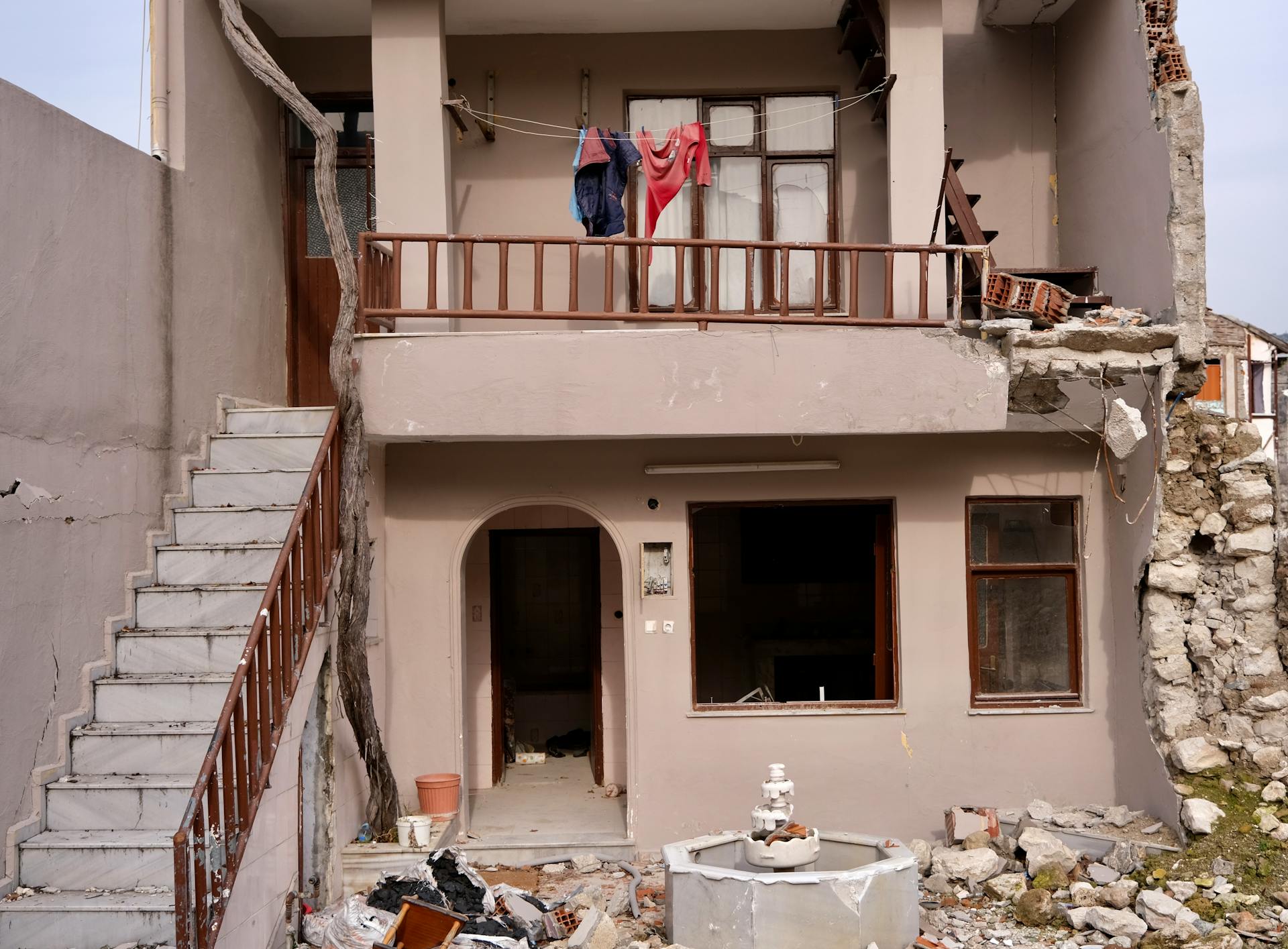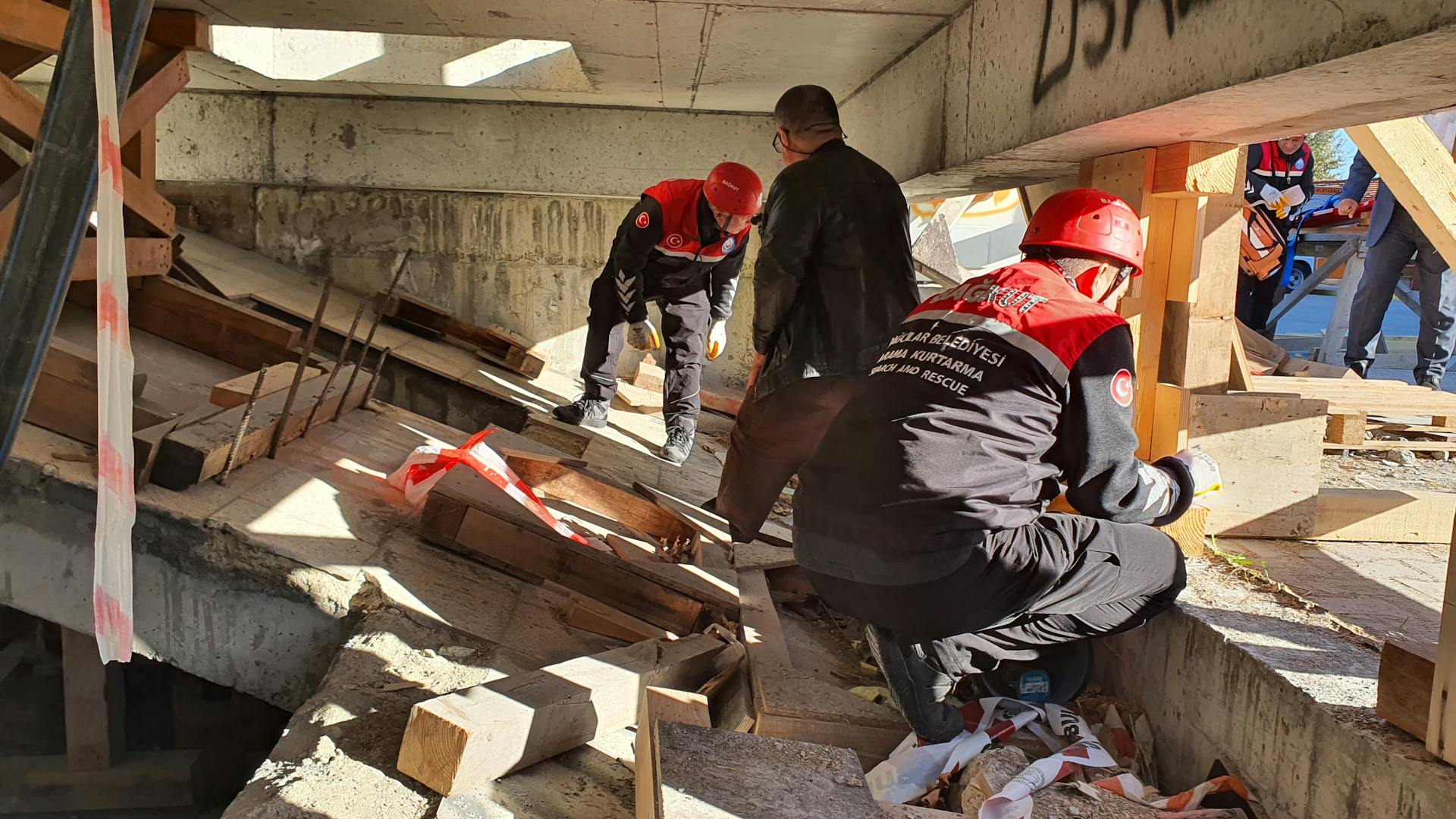
Homeowners insurance can be a lifesaver, but it's essential to understand what it covers and what it doesn't. Typically, standard homeowners insurance policies cover damage to your home's exterior, such as the roof, walls, and foundation.
However, the extent of coverage varies depending on the policy and the cause of the damage. For instance, most policies cover damage from windstorms, hail, and falling objects, but may not cover damage from floods, earthquakes, or maintenance-related issues.
In general, homeowners insurance policies are designed to protect your home from unexpected events, not from normal wear and tear. This means that damage caused by poor maintenance or neglect may not be covered.
Check this out: Household Insurance Cover
What Homeowners Insurance Covers
Your homeowners insurance policy typically covers damages to the structure of your home caused by a covered peril, such as a fire, windstorm, or hail.
Most standard policies include dwelling coverage, which covers damage to your home's foundation, walls, roof, and floors. A tree falling on your home during a storm is a classic example of a covered peril.

Your insurance policy may pay for repairs if your home's structure is damaged by a burst pipe or other plumbing issue. However, it's essential to review your policy carefully to understand the extent of your coverage.
Damage to your home's walls, roof, and floors is usually covered under your standard policy. But, it's crucial to note that insurance coverage may be limited, and certain types of damage may not be covered.
A covered peril can include a windstorm or hail, which can cause significant damage to your home's structure. Your insurance policy may pay for the necessary repairs, but you should review your policy to understand the specifics.
Consider reading: What Are the Three Main Types of Property Insurance Coverage
Preventing and Identifying Damage
Regular property inspections are key to preventing structural damage. This includes checking the foundation, roof, walls, and other structural components for any issues.
Cracks in basement walls or uneven floorboards are obvious signs of foundation damage, but other signs to look out for include cracks in sheetrock, tiles, or exterior masonry, sagging or shifting of floors, walls, ceilings, and support beams, a wet crawl space, misaligned doors, and insects.
Suggestion: Does Flood Insurance Cover Foundation Damage
To prevent water damage, ensure your roof is in good condition and your gutters are clear of debris, and consider installing storm shutters or reinforcing your windows to protect against severe weather events.
Regular pest control services can help prevent damage from pests and other animals. Sealing gaps or cracks in your home's foundation, roof, or walls can also help prevent pests from entering.
A HomeBuyer Report can cost around £400 for a conventional building, but it can save you money by identifying potential problems early on. If you have a listed building or an older home, you may need to consult a professional for a different course of action.
Signs of Damage
Cracks in your home's sheetrock, tiles, or exterior masonry are a clear indication of potential damage.
Sagging or shifting of floors, walls, ceilings, and support beams can be a sign of foundation damage.
A wet crawl space is a warning sign that needs immediate attention.

Misaligned doors can be a result of structural movement.
Insects, such as woodworm, can severely damage timber and compromise the structural integrity of your home.
Here are some specific signs of damage to look out for:
- Bulging or bowed walls
- Gap between an external wall and the floor
- Cracks in a window sill or lintel
- Cracks in walls
- Doors and windows that stick when opening and closing
- Nail pops
Cracks wider than 15mm in walls or lintels should be seen to as soon as possible.
How to Prevent
Preventing structural damage to your home or property can be costly to repair and may lead to significant inconvenience and disruption. Fortunately, there are several steps you can take to prevent structural damage from occurring in the first place.
Regular property inspections are essential to identify and address any issues as soon as they arise. This includes inspecting the foundation, roof, walls, and other structural components.
Ensuring your property is adequately insured is also crucial. A standard insurance policy may not cover events such as flooding or earthquakes, so it's essential to carefully review your coverage.
Installing storm shutters or reinforcing your windows can protect against severe weather events such as hurricanes or high winds. Sealing gaps or cracks in your home's foundation, roof, or walls can also prevent damage from pests and other animals.
Take a look at this: Does Home Insurance Cover Cracked Walls
A HomeBuyer Report can cost around £400 and can help identify potential problems before they become major issues.
Here are some key steps to prevent structural damage:
- Install drains in your yard to siphon off excess water
- Clean your gutters and spouts to prevent water from leaking into the soil
- Keep trees at a safe distance from your home to prevent root damage
- Regularly water your yard to prevent dry soil
- Have your foundation inspected every couple of years
When Is Repair?
So, you're wondering when repair is necessary? Your homeowners insurance policy will list every hazard or cause of damage that your insurer will cover.
To determine if your home's foundation damage is covered, check the dwelling portion of your policy coverage form.
If your foundation issues didn't come about because of any particular event, chances are homeowners insurance won't pay for repairs.
Take a look at this: Will Insurance Cover Foundation Repair
Filing a Claim and Costs
If you suspect your home's foundation issues are covered by homeowners insurance, reach out to your insurance company ASAP to start the claims process.
Taking photos and documenting the damage is crucial, as it will make it easier to prove your case and get a payout for foundation repairs. Take photos or videos of the affected areas of your home.
Your insurance company will likely send a claims adjuster to your home to assess the damage and confirm details about your claim. The adjuster will then send an independent contractor to survey the damage and give an estimate of repair costs.
Filing a Claim
Filing a claim is a crucial step in getting the help you need to repair your home's foundation damage. Reach out to your insurance company as soon as possible to start the process.
Taking photos and documenting the damage is essential. This will make it easier to prove your case and get a payout for foundation repairs. Take photos or videos of the affected areas of your home.
You'll need to fill out claims forms, which your insurance company will likely send to you after the inspection. An independent contractor will survey the damage and give an estimate of repair costs.
Discover more: Does Homeowners Insurance Cover Brick Repair
How Much Do I Have to Pay?
You'll want to know how much you'll have to pay if your homeowners insurance does cover structural issues like foundation damage. Your deductible is the amount you'll pay upfront, which can range from a few hundred to several thousand dollars.
You'll be responsible for paying any amount exceeding your homeowners policy's limits in the category of the dwelling itself. This can be a significant amount, typically ranging from $100,000 to $500,000, depending on the replacement cost of your home.
After paying your deductible, you'll need to pay any amount exceeding your policy's limits. For example, if your policy limits are $200,000 and the repair costs are $250,000, you'll need to pay the additional $50,000.
To avoid unexpected costs, it's essential to review your policy with your independent insurance agent. They can help you understand your coverage limits and deductible amount. You can also shop around for a policy with a lower deductible or pay more to increase your coverage limit.
Here's a rough estimate of what you might have to pay:
Keep in mind that these are just examples, and your actual costs may vary depending on your policy and the extent of the damage.
Homeowner's Responsibilities and Defects
As a homeowner, it's essential to understand your responsibilities and potential defects that may affect your insurance coverage. Your home insurance policy will pay for repairs to the foundation and basic structure of your home including its frame, walls, and roof when it’s damaged due to a covered peril.
You'll need to bring in a foundation specialist to investigate the problem if you suspect foundation issues. Their report will come in handy if you decide to file a claim with your insurance company.
It's crucial to determine the cause of your foundation issues to ensure a smooth claims process.
Homeowner's Defective Construction?
As a homeowner, you're responsible for maintaining your property, but what if the construction itself is defective? Defects can be costly and time-consuming to fix.
According to the law, a homeowner is not responsible for defects that were present at the time of sale or construction. In fact, the builder is typically liable for any defects that are their fault.
Defects can manifest in various ways, such as structural issues, water damage, or electrical problems. These issues can be costly to repair and may even pose safety risks.
The Uniform Commercial Code (UCC) governs sales and construction contracts, which means that builders must comply with its provisions to avoid liability. This includes providing a warranty for their work.
Take a look at this: Does Homeowner Insurance Cover Culcking
Repairs to Your
Your home insurance policy will pay for repairs to the foundation and basic structure of your home including its frame, walls, and roof when it’s damaged due to a covered peril.
You'll be covered up to your policy’s dwelling coverage limits, which can range from $100,000 to $500,000 depending on the replacement cost of your home.
A foundation specialist can help determine the cause of your foundation issues, and their report can be useful if you decide to file a claim with your insurance company.
The average homeowner pays between $2,000 and $7,500 for foundation repairs, according to 2022 pricing data from HomeAdvisor.
Contract Public Adjusters for Problems
If you're experiencing structural problems with your home or property, it's essential to seek professional assistance as soon as possible. A qualified public adjuster can help you navigate the claims process and ensure you receive the maximum possible compensation for your damages.
Structural issues such as foundation problems, water damage, or storm damage can occur even with the most careful planning and preparation. A public adjuster can assess the extent of your damages and negotiate with your insurance company to get you the coverage you need.
Intriguing read: Does Homeowners Insurance Cover Electrical Problems
Regular maintenance and protection from the elements can help minimize the risk of unexpected damages, but sometimes structural issues still occur. A public adjuster can help you navigate the complex claims process and get the compensation you deserve.
At Stellar Public Adjusters, they specialize in helping homeowners and property owners navigate the claims process and get the compensation they deserve. They have an experienced team of public adjusters who can help you assess the extent of your damages and negotiate with your insurance company.
If you've experienced structural issues or damage to your property, don't wait to seek help. Contact Stellar Public Adjusters today for a free consultation and let them help you get the compensation you deserve.
Take a look at this: Does Renters Insurance Cover Move Out Charges
Frequently Asked Questions
What is considered structural damage?
Structural damage refers to any damage that compromises the safety and stability of your home, including issues with the foundation, roof, and load-bearing walls. This type of damage can put your home at risk of collapse or failure, making it a serious concern for homeowners.
What is considered structural damage?
Structural damage refers to harm to a building's essential components, including its foundation, walls, roof, floors, and beams. This type of damage can compromise the building's safety and integrity, making it a serious concern for homeowners and property owners.
Sources
- https://www.stellaradjusting.com/does-home-insurance-cover-structural-problems/
- https://www.trustedchoice.com/ask-an-insurance-agent/does-home-insurance-cover-structural-issues/
- https://www.theaa.com/home-insurance/advice/structural-damage
- https://www.policygenius.com/homeowners-insurance/does-homeowners-insurance-cover-foundation-repair/
- https://www.steinberglawfirm.com/blog/does-homeowners-insurance-cover-defective-construction/
Featured Images: pexels.com


